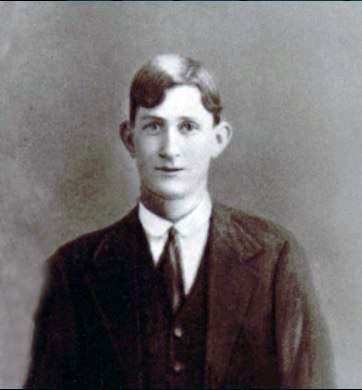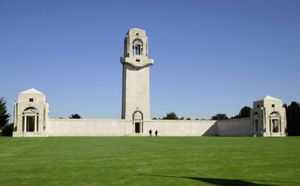Victor Henry Marshall
From Our Contribution
 Ancestry.com | |
| Personal Information | |
|---|---|
| Date of Birth |
unknown "unknown" contains an extrinsic dash or other characters that are invalid for a date interpretation. |
| Place of Birth | Wollongong, New South Wales |
| Death |
9 Apr 1917 1st Bullecourt "9 Apr 1917 1st Bullecourt" contains more than three components required for a date interpretation. |
| Place of Death | 1st Bullecourt, France |
| Age at Enlistment | 19 years, 7 months |
| Description |
5'5" (1.65m) tall ; 137 lbs 62.142 kg ; dark complexion ; greyish blue eyes ; dark brown hair |
| Occupation | Tailor |
| Religion | Presbyterian |
| Address | NOK East Cannington, Western Australia |
| Next of Kin | Mother , Mrs Elizabeth Marshall |
| Military Information | |
| Reg Number | 90 |
| Date of Enlistment | 10 Sep 1914 |
| Rank | Lance Sergeant |
| Unit/Formation | 16th Battalion, A Company, 1 Platoon / 4th Brigade, 4th Division |
| Date of Embarkation | 2 Dec 1914 ‒ 1 Feb 1915 |
| Ship Embarked On | HMAT A40 Ceramic |
| Fate | Killed in Action 11 Apr 1917 |
| Medals |
1914-15 Star British War Medal Victory Medal |
Pre War
War Service
Served in Gallipoli and France. Allocated to the 16th Battalion on entry into Blackboy Hill camp, one of its very early members. After training in Western Australia and Victoria they sailed for Egypt from Melbourne aboard HMAT A40 Ceramic, with their journey up the Suez Canal delayed by a Turkish attack near Kantara. They disembarked in Alexandria on 1 Feb 1915. On arrival at Alexandria they were placed on a train to Cairo, and camped on the Heliopolis aerodrome on the outskirts of Cairo. There the battalion changed its configuration from eight rifle companies to four. On 11 Apr 1915 the battalion travelled by train to Alexandria and boarded HMT Haida Pascha, a captured German ship. They arrived off Mudross harbour late on the 15th, and entered harbour the next morning. At noon on 25 April their ship set out for the Gallipoli Peninsula, and they were landed late that afternoon, with 'A' Company and Battalion HQ the first ashore.
On Gallipoli Victor received an injury to his left knee necessitating treatment on 22 May 1915 from the 4th Field Ambulance and evacuation on 23 May 1915 to HMHS Dunluce Castle, which carried Victor to Alexandria. He was admitted to 2nd Australian General Hospital in Cairo from 31 May 1915 - 1 Jun 1915 to have a growth removed. He rejoined his unit at Gallipoli on 28 Jul 1915 where they were in reserve. On 30 Aug 1915 he was treated by 4th Field Ambulance for gastro enteritis, and evacuated to Mudross, and then onwards to Cairo with HMHS Gloucester Castle, arriving there on 2 Sep 1915. Victor returned to Gallipoli for a third time on HMT Royal George, via Mudross West on 8 Dec 1915. Following the withdrawal to Egypt aboard HMAT A11 Ascanius (arrived 30 Dec 1915) and subsequent reorganisation of the Australian Imperial Forces, he travelled with his battalion from Alexandria to Marseilles on the HMT Canada arriving there on 9 Jun 1916. However, while back in Egypt he did require hospitalisation in the 1st Australian Stationary Hospital from 4 Feb 1916 until 21 Mar 1916 with gonorrhoea.
Promoted to Lance Corporal on 11 Sep 1916; then Corporal on 28 Oct 1916 and finally Lance Sergeant on 5 Mar 1917, the later as they prepared to re-enter the front lines.
There is an eye witness report of his death on 9 Apr 1917:
"Of A Coy 1st Platoon. On the night of 9th April 1917 these 3 men were sleeping in a dugout at the railway cutting towards Reincourt, but in front of the Hindenburg Line. Shell burst, and buried them. They were dug out as soon as possible, but all 3 were dead. It was impossible to bury them at that time."5026 LCpl D Baines1st Platoon, A Company.
However, Victor's records simply list him as one of the 14 Officers and 613 Enlisted who were casualties on the 11th April resulting from the attack on the Hindenburg Line between Bullecourt and Reincourt.
Post War
Victor's mother received a pension of 30/- fortnightly from 1 Jul 1917.
In May 1919 his parents still held hopes that he was alive, and thought that they could see his likeness in a photo of Australian soldiers taken at Longleat Hall in 1917. It took them some time to accept that he was not going to return.
Notes

